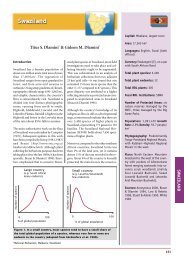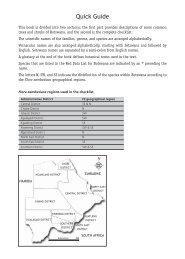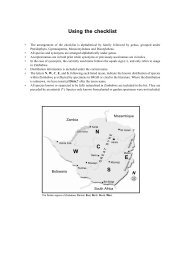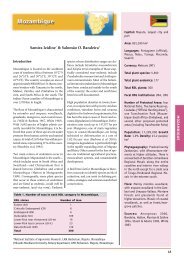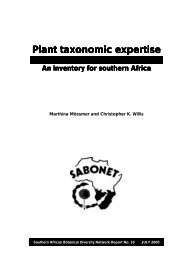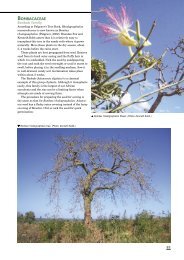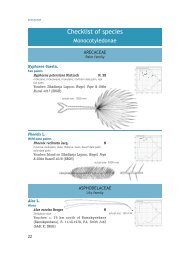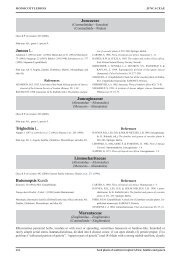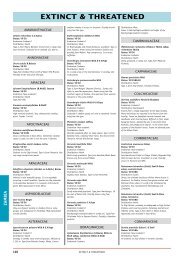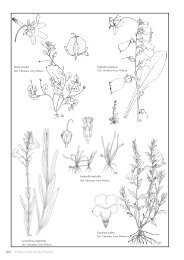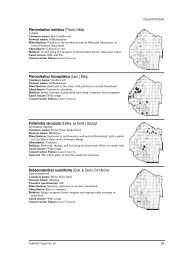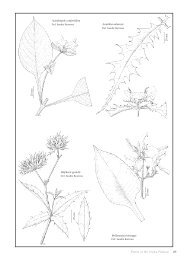141-172 - SABONET
141-172 - SABONET
141-172 - SABONET
You also want an ePaper? Increase the reach of your titles
YUMPU automatically turns print PDFs into web optimized ePapers that Google loves.
egion: high species concentrations are indeed<br />
often restricted to specific locations. Most of these<br />
areas are rich in endemics—plants that are confined<br />
to specific areas. The Drakensberg Mountain<br />
range in Lesotho and southeastern South Africa is<br />
one such area. The vegetation of the area has been<br />
classified differently by various scientists over the<br />
years:<br />
• Eastern Mountain Region (Phillips 1917)<br />
Austro-afroalpine Region (Van Zinderen-<br />
Bakker & Werger 1974)<br />
Austral Domain of the Afroalpine Region<br />
(Werger 1976, pers.comm. in Killick 1994)<br />
Afro-alpine Region (Killick 1978)<br />
Altimontane vegetation (White 1983)<br />
South-eastern Mountain Regional Mosaic<br />
(Hilliard & Burtt 1987)<br />
Drakensberg Alpine Region (CPD Site Af82)<br />
(Killick 1994)<br />
Alti/Afro Mountain Grassland (Low & Rebelo<br />
1996)<br />
Vegetation<br />
Broadly classified within the over-exploited<br />
grassland biome (Rutherford & Westfall 1986), the<br />
area was classified as Themeda-Festuca Alpine<br />
Veld (veld type 58) by Acocks (1975). The area<br />
consists essentially of species-rich subalpine<br />
(1800–2800 m) grasslands dominated by Themeda<br />
triandra, but with a wide variety of other<br />
monocotyledons and dicotyledons. There are also<br />
“patches of wet meadow and marshland at all<br />
altitudes and small areas of dwarf shrub heaths on<br />
steep and rocky ground” (Greyling & Huntley 1984).<br />
According to Schwabe (1990), there are three<br />
types of wetlands found within the SNPCtarns,<br />
riparian marshes and inland freshwater marshes.<br />
All are effective sediment traps and stabilisers of<br />
stream flow because of their capacity to store<br />
sediments and water. Tarns are depressions in the<br />
sandstone that are filled with water and have very<br />
little emergent vegetation associated with them. It<br />
is in these tarns that the rare Aponogeton<br />
ranunculiflorus, described in 1972, may be found<br />
(Jacot Guillarmod & Marais 1972; Jacot<br />
Guillarmod et al. 1973; Jacot Guillarmod 1977,<br />
1978). The species flowers in January and has<br />
been described by Zonneveld (1998) as the “jewel<br />
<strong>SABONET</strong> News Vol. 4 No. 2 August 1999<br />
of Sehlabathebe”. It was first discovered in the<br />
tarns of SNP. Subsequently, specimens were noted<br />
in tarns and pools along the Drakensberg escarpment,<br />
but all at approximately the same altitude of<br />
2 600 m. Its distributional range is restricted,<br />
however, to less than 10 km (Jacot Guillarmod<br />
1977, 1978). It has been listed as rare mainly<br />
because the habitat is so readily disturbed—<br />
erosion causes silting of the water which cuts out<br />
the light necessary for photosynthesis and subsequent<br />
growth of the plant (Jacot Guillarmod et al.<br />
1973). Within SNP, A. ranunculiflorus is found<br />
solely in the tarns in the eastern and southern parts<br />
of the park. The flower head is borne at the top of<br />
a long, slender peduncle, and the open inflorescence<br />
resembles a white buttercup floating on the<br />
water—hence the specific epithet ranunculiflorus.<br />
The leaves seldom reach 10 cm in length and are<br />
always under water: the clear pools, however,<br />
allow enough light to penetrate to allow photosynthesis<br />
to take place (Jacot Guillarmod 1977). It<br />
grows readily in cultivation (Jacot Guillarmod<br />
1978).<br />
Herbarium<br />
The 1970s was a decade of much activity in SNP,<br />
due largely to the efforts of Amy Jacot Guillarmod<br />
and three US Peace Corps volunteers whose names<br />
are intimately associated with the plants of SNP—<br />
Alan C. Beverly, Fred K. Hoener and M.K.<br />
Rutledge. Alan Beverly was the Associate Botanist<br />
in SNP from December 1975 to July 1977,<br />
whilst Fred Hoener was the Botanist from February<br />
1976 to September 1979 (Gunn & Codd 1981).<br />
Fred Hoener was responsible for compiling a<br />
checklist of the flora in SNP during 1979.<br />
Whilst working in SNP, the US Peace Corps<br />
volunteers established an herbarium (Sehlabathebe<br />
National Park Herbarium) which is housed in the<br />
Research Centre, close to the park’s main gate (see<br />
also Smith & Willis 1999a,b). This is probably the<br />
only A-framed building housing an herbarium in<br />
southern Africa. During their time in SNP, Hoener,<br />
Beverly and Rutledge managed to mount and<br />
deposit in the herbarium ca 950 specimens, representing<br />
238 genera and 469 species. The identification<br />
of most of the specimens were confirmed or<br />
determined by staff of the National Herbarium<br />
149



